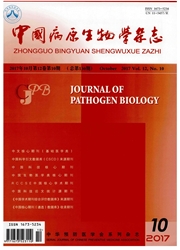

 中文摘要:
中文摘要:
目的构建旋毛虫氨基肽酶(TsAP)基因重组质粒,表达重组TsAP蛋白,评价该蛋白的血清学诊断价值。方法通过RT-PCR扩增TsAP基因。构建重组质粒pGEX-6p-1-TsAP,测序及酶切鉴定后转化E.coliBL21,用异丙基-G-D-硫代半乳糖苷(IPTG)诱导,表达产物经GSTSefinoseResin(BBI)亲和层析纯化后应用SDS-PAGE和Westernblot进行鉴定。应用旋毛虫重组rTsAP蛋白EusA(rTsAP-ELISA)对旋毛虫感染小鼠血清进行检测,观察旋毛虫感染小鼠后不同时间的血清抗体阳性率,并与旋毛虫肌幼虫ES抗原ELISA(ES-EIJIsA)的检测结果进行比较。结果构建的重组表达载体pGEX-6p-1-TsAP能表达TsAP蛋白。SDS-PAGE结果显示,rTsAP的分子质量单位约为80ku,以IPTG诱导4h后表达量最大。rTsAP-ELISA及ES-ELIS对旋毛虫感染小鼠血清的抗体检出率均为100%(40/40),与曼氏裂头蚴、弓形虫感染小鼠及正常小鼠血清均无交叉反应,与日本血吸虫感染小鼠血清的交叉反应率分别为93.75%(15/16)和50.00%(8/16)(P〈0.05)。rTsAP-ELISA与ES-ELISA对旋毛虫感染2周的小鼠血清抗体检出率分别为50.00%(11/22)和81.82(18/22),差异无统计学意义(P〈0.05),至感染后6周抗体检出率均达100%。结论重组TsAP蛋白具有良好的反应原性,但与日本血吸虫感染小鼠血清有较高的交叉反应。
 英文摘要:
英文摘要:
Objective To study the serodiagnostic value of the recombinant TsAP protein (rTsAP) of Trichinella spir- alis. Methods The TsAP gene was amplified using RT-PCR. The recombinant plasmid pGEX-6p-1-TsAP was con- structed, transformed into E. coli BL21 competent cells, and induced with IPTG. The expression products were purified using GST Sefinose Resin affinity chromatography. The antigenicity of the rTsAP was identified using SDS-PAGE and Western blotting, rTsAP-ELISA was used to detect antibodies in sera from mice infected with T. spiralis at different times after infection. The results of rTsAP-ELISA were compared with those of ELISA using excretory-secretory (ES) antigens from T. spiralis muscle larvae (ES-ELISA). Results The TsAP gene was successfully cloned and expressed. The results of SDS-PAGE revealed that rTsAP had a molecular weight of 80 ku. The level of its expression peaked at 4 h post-induction. The rate of antibody detection in sera from mice infected with T. spiralis was 100~ according to both rTsAP-ELISA and ES-ELISA. There were no cross-reactions between rTsAP or ES antigens and sera from mice infected with Spirometra rnansoni spargana, sera from mice infected with Toxoplasma gondii, or sera from normal mice. The rate of cross-reaction of rTsAP or ES antigens with sera from mice infected with S. japonicum was 93.75 % (15/16) and 50%(8/16), respectively (P〈0.05). The rate of antibody detection in sera from infected mice was 50%(11/22) and 81.82% (18/22), respectively, at 2 weeks post-infection (wpi) and rose as high as 100% (22/22) at 6 wpi(P〈0.05). Conclusion Recombinant T. spiralis aminopeptidase has good reactogenicity but a high rate of cross-reaction with sera from mice infected with S. japonicum.
 同期刊论文项目
同期刊论文项目
 同项目期刊论文
同项目期刊论文
 Normal Mouse Intestinal Epithelial Cells as a Model for the in vitro Invasion of Trichinella spirali
Normal Mouse Intestinal Epithelial Cells as a Model for the in vitro Invasion of Trichinella spirali 期刊信息
期刊信息
